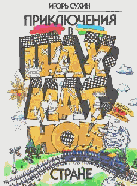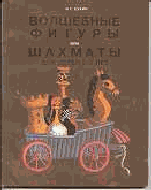
Chess for children aged 0 to 14, their parents and teachers
Chess
Chess is not only an enjoyable game but also an efficient means of developing children's logical thinking and will power. Teaching chess involves drawing on the intellectual and creative potential of the ancient game. The site gives some insights into special techniques of introducing the basics of chess to children aged 2 to 10, didactic tales and important materials meant for chess as a primary school option. All of these are based on a wide range of the author's innovative approaches, including: an extensive use of chessboard fragments in the process of learning, the practice of applying unconventional didactic tasks and games as well as staging original didactic fairy tales, a detailed study of each chesspiece's capacity, primary use of game positions with a limited number of chessmen, a well-thought-out application of a special lead-in game which ends in one of the players taking all the rival's pieces (in other words, a game without mate: a piece against a piece) with the ultimate introduction of the key chess term - "mate".
Chess books by I.G. Suhin:
1."ADVENTURES IN CHESSLAND", Moscow, Pedagogika Publishers, 1991 (in Russian).
2. "LA BOLSITA MAGICA. EL AJEDREZ PARA LOS MAS PEQUENOS", Espana, Academia Internacional de Ajedrez Kasparov, Asociacion de Centros de Ensenanza Internacional Marcote, 1992 (in Spanish). 3. "MAGIC PIECES, OR CHESS FOR CHILDREN WHO ARE 2 TO 5 YEARS OLD", Moscow, Novaya Shkola Publishers, 1994 (in Russian). 4. "CHESS, FIRST YEAR, OR WHERE SQUARES ARE FULL OF MYSTERY AND WONDER", Obninsk, Dukhovnoye Vosrozhdeniye Publishers, 1998 (in Russian). 5. "CHESS, FIRST YEAR, OR TEACH AND STUDY", Obninsk, Dukhovnoye Vosrozhdeniye Publishers, 1999 (in Russian). 6. "WONDERFUL ADVENTURES IN CHESSLAND", Moscow, Pomatur Publishers, 2000 (in Russian). 7. "CHESS FOR YOUNGER CHILDREN", Moscow, Astrel Publishers, 2000, 2001 (in Russian).
The annotations of two chess books by I.G. Suhin:
I.G. Suhin ADVENTURES IN CHESSLAND
Moscow, Pedagogika, 1991, 160 pp. illustrated by N.N.Anikushin

Summary:
This book is most unusual. For children, it is a fascinating fairy tale brimming with miracles and adventures. For grown-ups it is a manual containing original methods to teach preschoolers the ABC of chess game. The author introduces the 5-7 year olds to the world of chess, tells about the history of the game, explains elementary terms of the ancient game and helps clarify the power and weakness of each chesspiece. Teaching preschoolers to play chess is an efficient means of developing their logical thinking rather than an end in itself.
The book contains a didactic fairy tale of 14 chapters and other material grouped under the headings: "Riddles from the Notebook", "Advice for Parents", and "First Steps of Outstanding Chessplayers".
The fairy tale includes material for children to assimilate. Every chapter ends with problems to solve. The book concludes with a small "Chess Fairy Tale", the author's version of the history of the chessboard. This part is meant to be read together by children and adults.
"Advice for Parents" is naturally for grown-ups. Specific recommendations alternate with nontraditional didactic games developed by the author.
Another section, "First Steps of Outstanding Chessplayers", is for family reading too, if parents decide it might arouse their children's interest. Helpful hints from parents and tutors of future stars are scattered among relevant biographic information.
The concluding 19 pages are allotted to the Chess Vocabulary with additional chess terms that cannot be found in the book.
Contents:
Chess pavilion. Lines. Diagonal. Wonderful chessmen. I am a Castle. This Bishop does not behave like a Bishop. Visiting the Queen. Black and white knights. "Wonderful Pawn" kindergarten. Where does the King move? The fairy carpet. Checkmate and stalemate. Good-bye, Chessland. Chess fairy tale. Chess vocabulary.
The author:
I. G. Suhin ¢ research worker, Institute for the Theory of Education and Pedagogic, Russian Academy of Education; author of a unique technique of teaching the basics of chess to children aged 2 and upwards, an official Russian chess course for primary school as well as over 50 popular books on the following subjects: chess, literary games, entertaining mathematics, etc.
I.G. Suhin MAGIC PIECES, OR CHESS FOR CHILDREN WHO ARE 2 TO 5 YEARS OLD
Moscow, Novaya Shkola, 1994, 160 pp.
(A book for joint reading by parents and children aged 2 to 5)

Summary:
This book is addressed to the child and the parent teacher. Without haste, with due attention to the peculiarities of teaching children who are 2 to 5 years old, the author introduces the foundations of playing chess to younger preschoolers and proves the possibility of studying the ABC of chess since the age of 2. A 2-3-year-old child is already a personality with his or her specific inner world, with habits and wishes, - a personality who is stubbornly engaged in self-assertion. That is somebody who can speak, knows more than 1,000 words, moves splendidly, displays a keen interest in the surroundings and comes to realize who he or she is. Chess-playing contributes to a great extent to the development of the child's mind. The experience of playing the game provides a special property of thinking (thinking in form of ideas). It enables the kid to understand other people's points of view, to anticipate their future behaviour and think over his own actions. The book has grown out of the author's long work as a teacher introducing the foundations of the ancient game to 2-7-year-old children.
Composition:
The book consists of a didactic fairy tale divided into 30 very short chapters and a special part entittled "Useful tips". The chess material to be assimilated by children is an integral part of the fairy tale. The story is quite simple and is accessible to 2-5 year-old children: Pencil, a magic painter, draws living pictures ¢ chesspieces and squares on the chessboard. Dunno explains to his friends: Thumoerline, Chipollino, Hurvinek, Punch, Samodelkin, Pinokkio ¢ how chesspieces move and take each other, how to announce check and mate and how to escape stalemate. While the didactic fairy tale is designed for children's reading, the section "Useful tips" which is placed after each chapter is addressed to adults. It gives specific pieces of advice on conducting chess lessons, on revising the material explained and arranging unconventional didactic games. Here there are also blocks of initial positions to be played by parents with children. These blocks are differentiated according to ages. For exercises the author suggests practising openings comprehensible by children: those aged 2-3 and a half, 4 and a half, 5 and a half, and, finally, especially gifted children. The optimum variations of playing and positions are given and attention is paid to the most typical errors.
The author:
I. G. Suhin ¢ research worker, Institute for the Theory of Education and Pedagogic, Russian Academy of Education; author of a unique technique of teaching the basics of chess to children aged 2 and upwards, an official Russian chess course for primary school as well as over 50 popular books on the following subjects: chess, literary games, entertaining mathematics, etc.
From my foreign correspondence "LA BOLSITA MAGICA. EL AJEDREZ PARA LOS MAS PEQUENOS" (in Spanish) "Educational Course in Chess for Primary School" mailto:suhin_i@mail.ru
suhin_i@mail.ru
http://chess555.narod.ru/for2.htm
® 2003-2006 Suhin I.G.